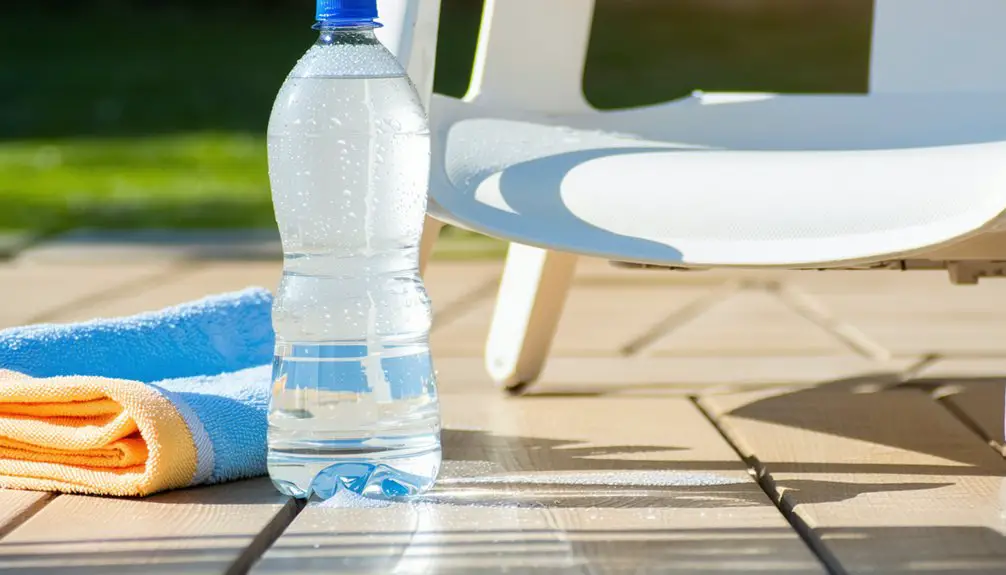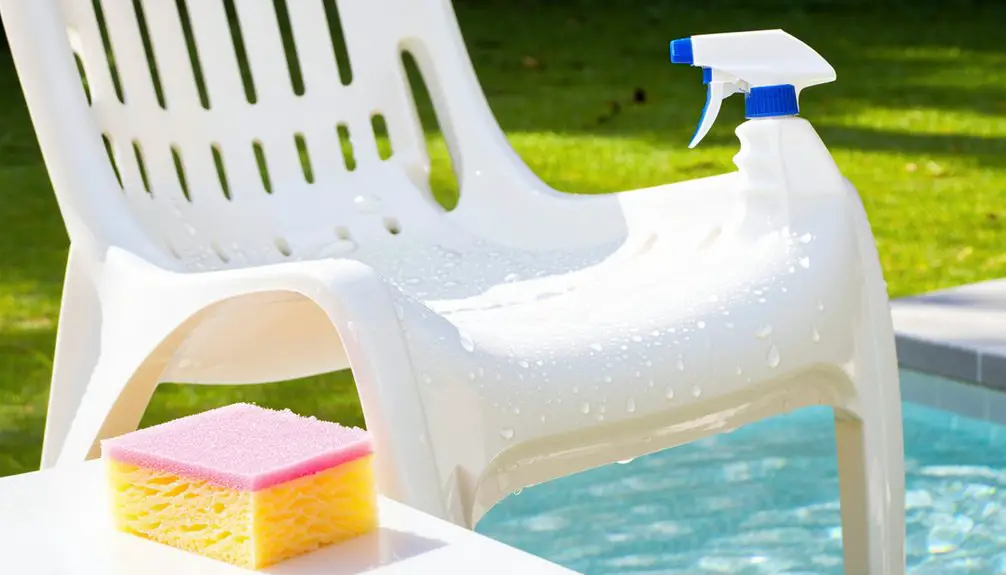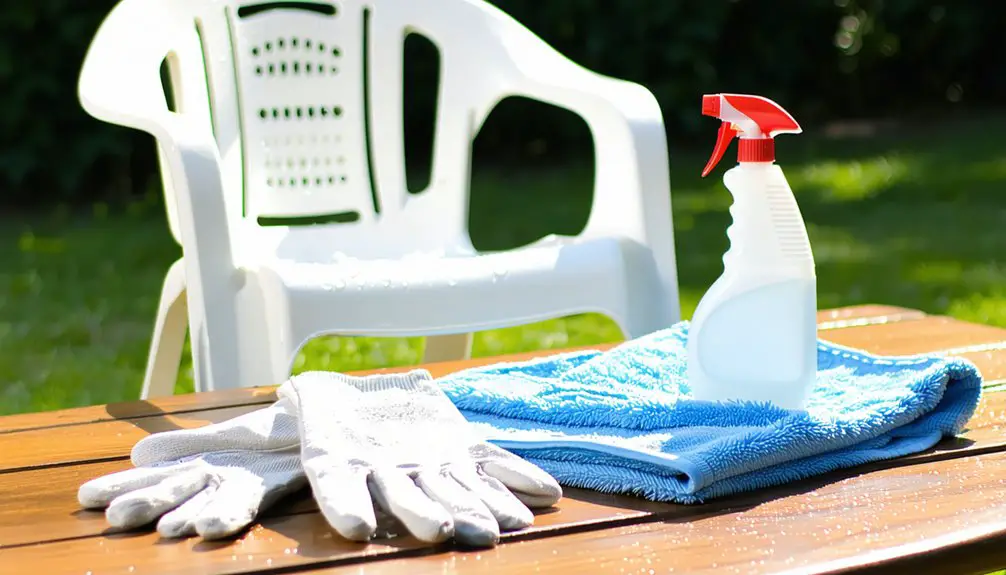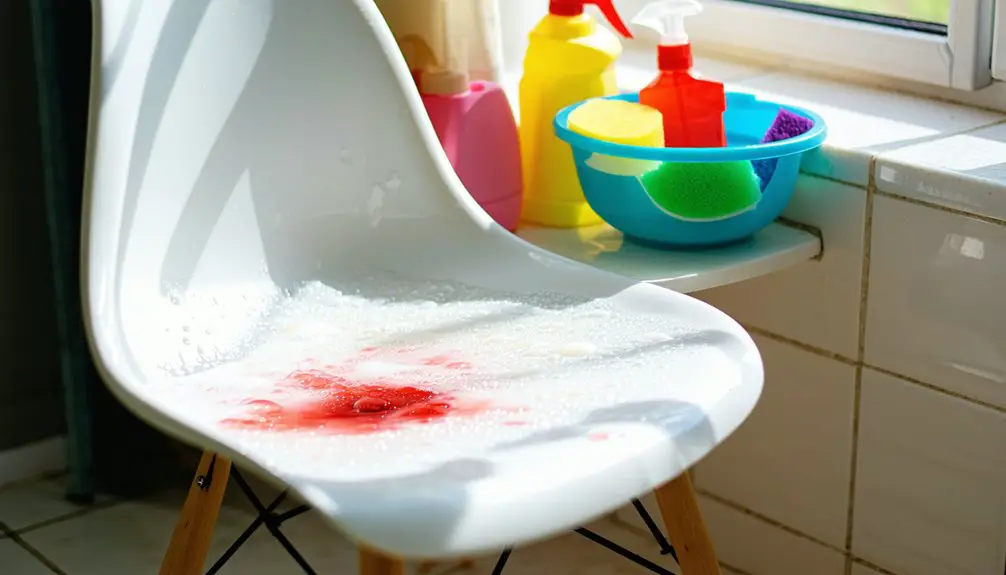To effectively remove stains from plastic furniture, start with warm soapy water and a soft cloth for regular maintenance. For tougher stains, mix equal parts vinegar and water or use a baking soda paste. Apply this directly to the stain and let it sit before scrubbing gently. For oil-based stains, try a specialized remover. Always rinse thoroughly after cleaning to avoid residue. If you've got stubborn marks, experimenting with lemon juice or a baking soda blend can help. With the right tips and tricks, you'll keep your plastic furniture looking brand new—there's plenty more to discover.
Key Takeaways
- For general stains, mix ¼ cup white vinegar with warm water, scrub, and rinse thoroughly.
- For oil-based stains, use Sunbrella Extract Oil Based Stain Remover, spray, and vacuum after drying.
- Treat stubborn stains by applying salt with a damp cloth or using lemon juice for enhanced effectiveness.
- For ink or dye stains, apply rubbing alcohol or hand sanitizer directly onto the stain for removal.
- Always test cleaning solutions on a small area first to prevent potential damage to the plastic surface.
General Cleaning Tips
When it comes to keeping plastic furniture clean, a few simple strategies can make a big difference. Start with warm soapy water; just mix it with a small amount of dishwashing soap or laundry detergent. This solution's great for routine maintenance and light dirt. Regular cleaning helps prolong the lifespan of plastic furniture. Using a mild soap solution for general cleaning can also help prevent bacteria and maintain appearance.
Be careful not to use too much water, as it can damage the finish. Grab a soft cloth or sponge to clean, and rinse thoroughly with a garden hose or power hose.
For tougher stains, try a vinegar and water mixture. Combine warm water with 1/4 cup of white vinegar, let it sit on the stain for a few minutes, then scrub gently. Rinse it off and dry with a soft towel or let it air dry.
To prevent dirt buildup, make regular wipe-downs part of your routine. Use a soft cloth to avoid scratching the surface, and clean up spills immediately to stop stains from setting in.
Effective Use of Bleach
When you're tackling tough stains on plastic furniture, bleach can be a powerful ally if used correctly.
Start by preparing a well-diluted bleach solution, then apply it carefully to the stained area, keeping safety precautions in mind. Overuse of bleach can lead to discoloration and weakening of plastic materials if not rinsed thoroughly afterward.
Bleach Preparation Steps
Preparing a bleach solution is essential for effective cleaning and disinfecting of plastic furniture. Start by measuring the water first, then carefully add bleach to avoid contact with undiluted bleach. Here's a quick reference table for your bleach preparation:
| Purpose | Bleach Amount | Water Amount |
|---|---|---|
| General Cleaning | 1/4 cup | 1 bucket of warm water |
| Disinfecting | 1 tablespoon | 1 gallon of water |
| Spot Test | 1 tablespoon | 1 cup of water |
Always wear protective rubber gloves and ensure your workspace is well-ventilated. Avoid using bleach on colored plastic, as it can cause fading. It's also crucial to steer clear of aluminum, wood, and other sensitive materials. After applying your bleach solution, rinse thoroughly with clean water to eliminate any residue. Regular cleaning is key to maintaining a bright and hygienic finish on your plastic furniture. Remember, bleach solutions should be freshly made daily, as they break down quickly. Allow the surface to air dry in the sun to prevent water spots, ensuring a clean, bright finish for your plastic furniture.
Application Techniques
Effective application of bleach solutions is crucial for tackling stains on plastic furniture. Start by mixing one part chlorine bleach with ten parts water to create a potent solution. Use a sponge or damp cloth to apply the mixture directly onto the stained area, ensuring it's spread evenly to avoid uneven cleaning. Allow the solution to sit for 10-15 minutes before rinsing it off.
When scrubbing, use a soft brush or sponge, moving in circular motions over the stained spots. If necessary, apply a bit more pressure, but be careful not to damage the plastic. After scrubbing, rinse the furniture thoroughly with warm water to eliminate any bleach residue. Dry the surface with a microfiber cloth or let it air-dry to prevent water spots. Understanding the causes of stains on plastic furniture can help you select the most effective cleaning methods tailored to your specific needs.
If you prefer a safer alternative, consider using oxygen bleach. Mix 4 liters of lukewarm water with ½-1 cup of powdered oxygen bleach, applying it similarly with a sponge or soft-bristled brush. Let it sit for 15-20 minutes, as it can be left on longer without harming the furniture.
Always test any solution on an inconspicuous area first.
Safety Precautions
Using bleach safely is essential to protect yourself and your plastic furniture. Start by wearing eye protection and gloves to prevent irritation and skin exposure. Good ventilation is crucial, so always work in an open area. Keep kids and pets away while you're using bleach to avoid accidental exposure.
Never mix bleach with other chemicals unless you're sure they're compatible, as this can create hazardous gases. Be cautious with bleach on colored or textured surfaces, as it can cause discoloration. Remember, bleach is corrosive, so don't use it on surfaces that can't handle its strength, and avoid using it on delicate coatings like those on hardwood floors.
When cleaning outdoors, dilute bleach with plenty of water to protect your grass and plants. Avoid using it where runoff could harm aquatic life. Additionally, consider using protective covers to shield your furniture from the elements to enhance its lifespan.
After using bleach, rinse the area thoroughly and ensure it's dry before applying other products. Always adhere to exposure limits set by safety organizations to avoid health risks. If you experience severe exposure or ingestion, seek immediate medical attention.
Consider gentler alternatives like white vinegar or baking soda for safer cleaning options.
Cleaning With White Vinegar

If you're looking for a safe and effective way to clean your plastic furniture, white vinegar is a great option.
You can easily mix it with warm water to create a powerful cleaning solution.
Let's explore the benefits of using white vinegar, how to mix it properly, and the best scrubbing techniques for your furniture.
Benefits of White Vinegar
Harnessing the power of white vinegar in your cleaning routine offers numerous benefits, especially when it comes to maintaining plastic furniture. For starters, it effectively dissolves grime and residues, making it an ideal choice for tackling stubborn stains.
You can easily remove mildew stains by mixing ¾ cup of distilled white vinegar with ¼ cup of water and letting it sit for 10 minutes. If you have colored plastic furniture, a gentler mix of ¼ gallon of warm water with ¼ cup of vinegar will do the trick without damaging the colors.
White vinegar is also gentle and non-abrasive, ensuring your furniture stays looking fresh. Unlike harsh chemicals, it won't stain or discolor surfaces, making it a safe option for regular cleaning. Plus, it's environmentally friendly!
In addition to its cleaning prowess, white vinegar acts as a sanitizer and deodorizer, significantly reducing bacterial counts and eliminating unpleasant odors.
Its versatility extends to various cleaning applications, from degreasing appliances to descaling coffee makers. Embracing white vinegar in your cleaning arsenal ensures your plastic furniture remains in top shape while promoting a healthier home.
Mixing the Cleaning Solution
Creating an effective cleaning solution for your plastic furniture is simple and can make a significant difference in tackling stains. To whip up a general cleaning solution, mix equal parts of white vinegar and water. Using a spray bottle makes for easy application, and if you use warm water, the solution's effectiveness increases.
For colored plastic furniture, consider a milder mix—¼ gallon of warm water with ¼ cup of vinegar. This gentler approach preserves the surface while still addressing stains.
If you're dealing with mildew, combine ¾ cup of distilled white vinegar with ¼ cup of water. Spray this on the affected areas and let it sit for about 10 minutes; the acetic acid in vinegar works wonders against mildew.
For stubborn stains like grease or food residue, soak a cloth or sponge in distilled vinegar, then apply it directly to the stain. Let it sit for a few minutes to penetrate the grime.
For oxidation stains, after applying vinegar, sprinkle baking soda on a damp sponge to gently scrub the area. This combination effectively restores your furniture's appearance without causing damage.
Effective Scrubbing Techniques
Scrubbing your plastic furniture effectively involves a few straightforward techniques that can significantly enhance the cleaning process.
Start by preparing the surface; use a soft brush or sponge to gently remove loose dirt and debris. Hose down the furniture with a gentle setting to clear off any surface grime, and then wipe it with a damp microfiber cloth. Check for stubborn stains that need extra attention.
Next, apply your vinegar solution. Dampen a clean cloth with undiluted white vinegar and wipe the plastic surfaces. For stained areas, dip a scrub brush into the vinegar and gently scrub, focusing on those tough spots. If stains persist, mix vinegar with salt and let it sit for a few minutes for added cleaning power.
As you scrub, use light to moderate pressure with your soft brush or sponge to avoid scratching the plastic. Pay close attention to scuffs and stains, working methodically.
Rinse the furniture thoroughly with a garden hose to remove the vinegar solution and any loosened dirt. Finally, pat the furniture dry with a soft towel or let it air dry in the sun before using it again.
Techniques for Specific Stains
When tackling specific stains on plastic furniture, it's crucial to identify the type of stain before diving into removal techniques. Each stain requires a tailored approach for effective removal.
- Oil-Based Stains: Use Sunbrella Extract Oil Based Stain Remover. Spray in a circular motion and let it dry before vacuuming.
- Water-Based Stains: Mix 1/4 cup of white vinegar with warm water. Scrub with a brush and rinse well.
- Stubborn Stains: Sprinkle salt on the stain and rub with a damp cloth. Lemon juice can enhance the cleaning power.
- Ink or Dye Stains: Apply rubbing alcohol or hand sanitizer directly to the stain for effective removal.
- General Stains: For a potent bleach solution, mix 1 part chlorine bleach with 10 parts water. Apply, let sit for 10-15 minutes, then rinse thoroughly.
Remember to always test any cleaning solution on a small, inconspicuous area first to avoid damage.
With these techniques, you'll be well-equipped to tackle various stains and keep your plastic furniture looking its best!
Post-Cleaning Maintenance

Post-cleaning maintenance is essential for preserving the beauty and durability of your plastic furniture. To prevent future stains, use mild detergents and steer clear of abrasive cleaners that can damage the surface. A thin coat of automotive paste wax can offer added protection against stains, while coasters help shield the furniture from hot objects.
Regular cleaning is crucial; wipe down your furniture with a soft cloth or sponge to avoid scratches. Rinse with warm water, and make sure you dry the surface completely to prevent water spots. For ongoing maintenance, opt for a damp cloth for a quick shine instead of chemical-based products.
Avoid harsh waxes or polishes as they can harm the plastic. Instead, consider commercial products designed specifically for plastic furniture. When using any cleaning solution, always test it on a small area first to ensure it doesn't damage the finish.
Natural Cleaning Alternatives
Exploring natural cleaning alternatives can be a game-changer for maintaining your plastic furniture.
These eco-friendly options aren't only effective but also gentle on your surfaces. Here are some fantastic natural cleaning agents you can use:
- White Vinegar: Removes stains, dissolves grease, and can be mixed with water for an all-purpose cleaner.
- Baking Soda: Acts as a gentle abrasive for scrubbing tough stains, deodorizes, and is biodegradable.
- Lemon Juice: Cuts through grease and grime, kills mold, and adds a fresh scent while disinfecting.
- Melamine Foam: A gentle abrasive that polishes out stains, effective for stubborn marks, and eco-friendly.
- Essential Oils: Provide antimicrobial properties and add pleasant fragrances to your cleaning solutions.
Safety Precautions and Tips

Keeping safety in mind is crucial while cleaning your plastic furniture. Start by wearing protective gear like rubber gloves, safety goggles, and a mask to avoid skin irritation and inhaling fumes.
Ensure you're in a well-ventilated area to minimize chemical exposure. Remember, never mix cleaning agents, especially bleach, as this can create toxic reactions.
Before applying any solution, test it on a small, hidden area of the plastic to check for any adverse effects. Always follow the instructions on cleaning products closely. If you're using bleach, dilute it properly with water, and avoid applying it to sensitive plastics.
Protect work surfaces from spills, and keep harsh chemicals away from your skin.
When cleaning, use soft cloths, sponges, or soft-bristled brushes to avoid scratching the surface. After cleaning, rinse thoroughly with clean water to ensure all residues are removed.
Once done, dry the furniture completely to prevent moisture damage. Regularly inspect your plastic furniture for any signs of wear, and store it in a dry area to prolong its life.
Following these safety precautions will help keep both you and your furniture in great condition.
Frequently Asked Questions
Can I Use a Pressure Washer to Clean Plastic Furniture?
Yes, you can use a pressure washer on plastic furniture, but be careful. Start six feet away, test a hidden area, and avoid high pressure to prevent damage. Always rinse thoroughly afterward for best results.
How Often Should I Clean My Plastic Furniture?
You should clean your plastic furniture every two weeks or monthly, depending on usage and conditions. If you spot dirt or debris, clean it immediately to prevent buildup and maintain its appearance and durability.
Is It Safe to Use Dish Soap for Cleaning?
It's not always safe to use dish soap for cleaning. It can strip protective layers, cause fading, and leave residues. For better results, consider gentler alternatives like white vinegar or baking soda for your plastic surfaces.
Can Sunlight Damage Plastic Furniture Over Time?
Yes, sunlight can damage plastic furniture over time. UV rays cause fading, discoloration, and brittleness, leading to cracks and loss of structural integrity. Protect your furniture by using UV-resistant materials or placing them in shaded areas.
What Should I Do if Stains Persist After Cleaning?
If stains persist after cleaning, reassess the stain type, try different cleaning agents, or combine solutions. Always test new methods on a small area first to avoid damage and adjust concentration as needed.

